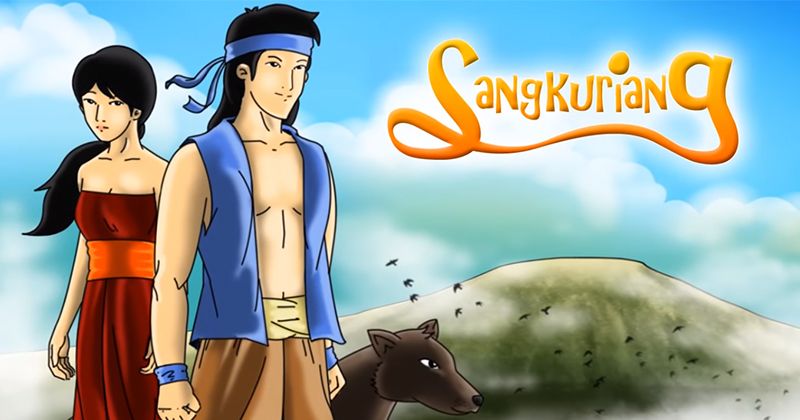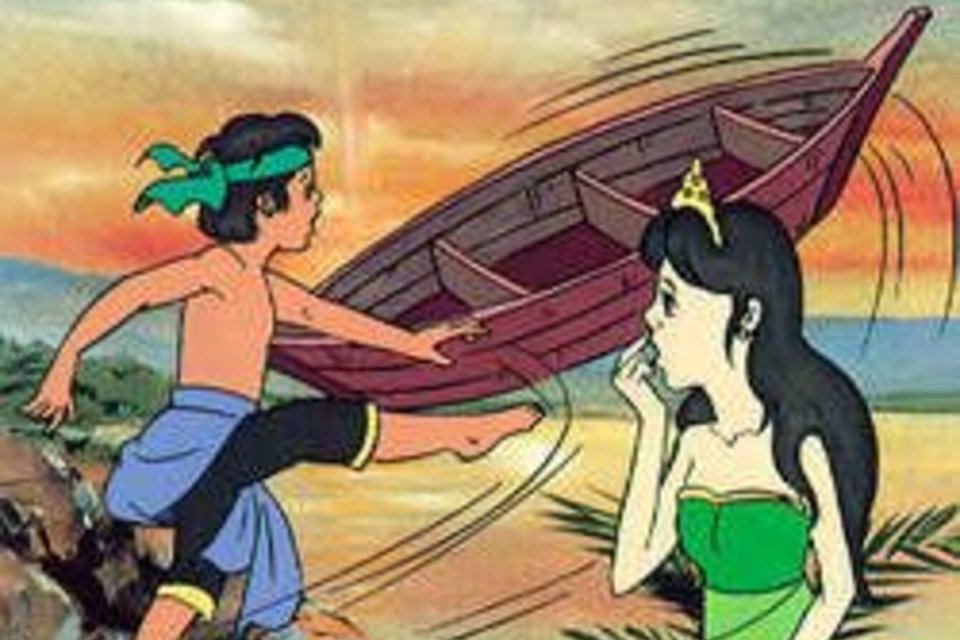The Legend of Sangkuriang
The Legend of Sangkuriang- Once upon a time, there was a beautiful princess named Dayang Sumbi, who lived in a kingdom surrounded by mountains and forests. She was a skilled weaver, and one day, while weaving, she accidentally dropped her woven cloth. A dog named Tumang appeared out of nowhere and retrieved it for her. Dayang Sumbi, grateful for the dog’s help, promised to marry him.
However, Dayang Sumbi did not realize that Tumang was actually a magical being, a celestial god in disguise. After they married, they had a son named Sangkuriang. Over the years, Sangkuriang grew strong, but one day, Dayang Sumbi realized that Sangkuriang bore a striking resemblance to Tumang, her husband, and she became suspicious. Eventually, Dayang Sumbi discovered the truth about Tumang’s divine nature and their marriage, leading to her rejection of Tumang.
After some time, Sangkuriang went hunting, and his mother ordered him to kill Tumang, though she did not reveal that Tumang was his father. When Sangkuriang unknowingly killed Tumang, his mother was heartbroken, and she punished him by casting him out of the house.
Years passed, and Sangkuriang, now a young man, returned to his homeland. He met Dayang Sumbi again, but she didn’t recognize him, for he had grown into a strong, handsome man. Dayang Sumbi, however, still felt an eerie sense of familiarity. As they became closer, Sangkuriang, unaware that Dayang Sumbi was his mother, fell in love with her. She, too, found herself attracted to him.
When they decided to marry, Dayang Sumbi had a premonition that he might be her son. To test him, she set an impossible task: to build a huge boat and a dam to make a lake within one night. Sangkuriang, determined to fulfill her wish, began working with supernatural speed, assisted by spirits and magical creatures.
As the sun began to rise, Dayang Sumbi, in desperation, called on the rooster to crow, signaling the dawn. The rooster, upon hearing her call, crowed so loudly that it frightened the spirits and broke the magic. Sangkuriang failed to complete the tasks in time.
Out of anger and frustration, Sangkuriang kicked the boat he was building, sending it flying to the sky. The boat became Mount Tangkuban Perahu, a famous mountain in West Java, shaped like an overturned boat, which can still be seen today.
Dayang Sumbi, heartbroken, realized that her son had been unknowingly tricked into falling in love with her. She was left to mourn, and Sangkuriang, realizing his mistake, disappeared into the wilderness.
Moral of the Story:
The legend of Sangkuriang is often interpreted as a tale of destiny, the consequences of forbidden love, and the importance of recognizing and honoring familial relationships. It also serves as an explanation for the natural landscape in the region, such as Mount Tangkuban Perahu, which is believed to be the result of the failed construction of a boat.
This captivating myth remains an important part of Indonesia’s rich cultural heritage!
The theme of the Sangkuriang folktale revolves around forbidden love, fate, and the consequences of one’s actions. It highlights several key aspects:
Forbidden Love: The central relationship between Sangkuriang and Dayang Sumbi is portrayed as tragic due to their unknowingly incestuous bond. Their love is thwarted by destiny and societal norms.
Fate and Destiny: The story emphasizes how fate plays a crucial role in the lives of the characters. Despite Sangkuriang’s good intentions, he is unable to escape the tragic events set in motion by his past actions and the curse upon him.
Consequences of Actions: Sangkuriang’s actions, driven by passion and ambition, lead to disastrous outcomes, underscoring the moral that one's choices can have far-reaching consequences.
Transformation and Loss: The tale also touches on themes of personal growth and loss, as Sangkuriang transforms from a hopeful lover to a heartbroken figure, illustrating the painful experiences of life.
Test
Explain the main theme of the Sangkuriang story and how this theme is reflected in the characters of the main figures.
Describe the characters of Sangkuriang and Dayang Sumbi. How do their traits affect the course of the story?
Identify and explain the conflict that occurs in the Sangkuriang story. What is the main cause of this conflict?
Analyze how the mythological elements in the Sangkuriang story reflect the beliefs of society in the past. What moral messages can be derived from it?
Explain the role of the setting in the Sangkuriang story. How does the setting influence the development of the story and its characters?
Discuss the meaning behind the ending of the Sangkuriang story. What lessons can we learn from this tragic outcome?
Compare and contrast Dayang Sumbi with another character in the story (e.g., Sangkuriang or Si Kancil). What makes them different or similar?
Identify symbols present in the Sangkuriang story (e.g., Mount Tangkuban Perahu) and explain their meanings.
Write about the moral messages that can be derived from the Sangkuriang story. How are these values relevant to modern life?
Create an alternative ending for the Sangkuriang story. What would happen if Sangkuriang and Dayang Sumbi were not separated?
The Sangkuriang myth is a popular tale from the Sundanese culture of Indonesia, rich in symbolic meanings and demonstrating various mythological elements that reflect societal beliefs. Here’s an analysis of how these elements connect to the beliefs of the society in the past, as well as the moral messages embedded within the story.
Mythological Elements and Societal Beliefs
Creation Myths:
- The story features elements of creation, particularly in the setting and the way the Lake Tangkuban Perahu is formed from Sangkuriang's failed attempts to create a dam. This reflects the community's connection to nature and shows how natural features were often explained through human stories, providing a way to understand the world around them.
Cultural Identity:
- Sangkuriang’s journey and actions represent the values of perseverance and determination prevalent in society. His quest mirrors the struggles faced by the community, echoing important cultural values such as resilience and the importance of familial relationships.
Taboos and Consequences:
- The story addresses the consequences of defying societal norms, particularly through the incestuous relationship that Sangkuriang unknowingly pursues with his mother, Dayang Sumbi. This taboo highlights the strict moral codes surrounding family and relationships in traditional society, emphasizing the importance of maintaining social harmony and proper conduct.
Role of Fate:
- The concept of fate or destiny is prominent, indicating a belief in predetermined paths that individuals must navigate. Sangkuriang's tragic fate serves as a reminder of the limitations placed on individuals by fate, as well as the overarching power of the divine or supernatural in human lives.
Moral Messages
Respect for Nature:
- The myth emphasizes the relationship between humans and nature, encouraging respect and harmony with the environment. Sangkuriang's failure to control nature serves as a warning against hubris and the consequences of disrespecting natural laws.
Importance of Knowledge and Wisdom:
- The story reflects on the idea that wisdom and knowledge are paramount. Sangkuriang's ignorance of his true identity leads to tragic consequences, suggesting that individuals must seek knowledge and understanding to avoid mistakes.
Consequences of Actions:
- The narrative teaches that every action has repercussions. Sangkuriang’s tragedy illustrates the notion that individuals must consider the consequences of their deeds, as even well-intentioned actions can lead to dire outcomes if not thought through carefully.
Family and Honor:
- The focus on familial relationships highlights the value of family honor and duty. The story serves as a reminder of the importance of recognizing one’s obligations to family and society, reinforcing traditional values of respect and loyalty.
Conclusion
The Sangkuriang story is a rich tapestry of mythological elements that reflect the beliefs and values of Sundanese society in the past. Through its themes of creation, consequence, and moral lessons, it provides insight into the community's cultural identity, their relationship with nature, and the significance of familial ties and social norms. These elements together illustrate not only historical beliefs but also timeless moral messages that continue to resonate today.




Komentar
Posting Komentar